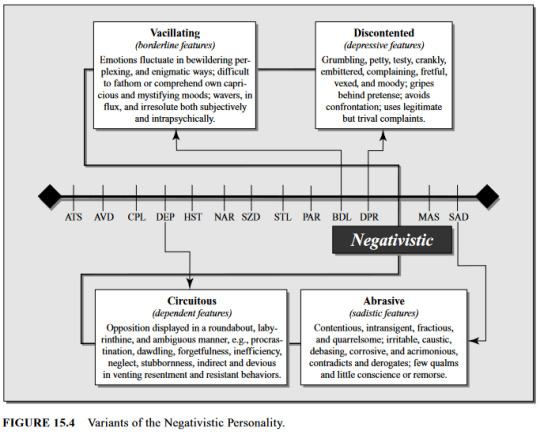#reading lane's article should be 101 for anyone interested in psych [/DSM] criticism
Explore tagged Tumblr posts
Text
Passive-Aggressive / Negativistic (PA/NegPD)
Note: You cannot be diagnosed with this disorder, as it's not in any diagnostic manual; you would be diagnosed with Other Specified Personality Disorder instead.
Criteria from the DSM-IV-TR (2000):
A pervasive pattern of negativistic attitudes and passive resistance to demands for adequate performance, beginning by early adulthood and present in a variety of contexts, as indicated by four (or more) of the following:
passively resists fulfilling routine social and occupational tasks
complains of being misunderstood and unappreciated by others
is sullen and argumentative
unreasonably criticizes and scorns authority
expresses envy and resentment toward those apparently more fortunate
voices exaggerated and persistent complaints of personal misfortune
alternates between hostile defiance and contrition
Millon's subtypes:

(Millon, ed.).
About PA/NegPD
PA/NegPD is similar to histrionic, dependent, avoidant, depressive, borderline, antisocial, paranoid, masochistic, obsessive-compulsive and narcissistic PDs. It's part of what Millon & Bloom term the "Aggressive Personality Patterns", along with AsPD, NPD, & Sadistic PD.
Renamed Negativistic PD in the DSM-IV; Millon suggested renaming it “oppositional personality disorder” (Lane).
Differential diagnoses include mood disorders, anxiety disorders, somatic disorders, and Oppositional Defiant Disorder. Many children who are diagnosed with ODD will develop PA/NegPD (Millon).
The most common PD comorbidities with PA/NegPD are AvPD (22.78%), AsPD (22.64%), & Sadistic PD (15.36%). The least common was OCPD (0.94%). Less than 1 percent (0.81%) had only ("pure") PA/NEGPD [less than those who had comorbid OCPD] (Millon & Bloom).
Millon defines it on a spectrum from sceptical -> negativistic (Millon Personality Group); or alternatively from discontented [personality type] -> resentful [style] -> negativistic [disorder] (Millon).
In the first DSM, it “... consisted of three subtypes - passive-dependent type who are helpless, overly dependent, and indecisive; passive-aggressive type who express their aggressiveness through passive means like pouting, procrastination, and intentional inefficiency; and the aggressive subtype who react to frustration with irritability, temper tantrums, and overt destructive behaviours” (Coolidge & Segal).
In the DSM-II it was described as being “characterized by passivity and aggression through obstinate behavior, procrastination, stubbornness, and intentional inefficiency” (Coolidge & Segal).
The DSM focuses on its overt/external behaviours and therefore miss its "cardinal qualities"; "underlying the behavior characterizing this personality pattern are profound confusion and ambivalence about self", similar to OCPD but with different coping strategies (Millon & Bloom)
It was a Cluster C PD, but in the DSM-IV & IV-TR it was moved to the Conditions for Further Study section “[d]ue to poor reliability and questionable validity and usefulness” (Coolidge & Segal). It wasn't included in any capacity in later editions.
PA/NegPD has a long history of ‘questionable validity’, as it originated in US military documents about reluctant soldiers during WWII, and continued throughout its history in the various DSMs to have criteria that could theoretically apply to anyone (e.g. dissatisfaction with their job or “personal misfortunes”, feeling misunderstood or unappreciated, complaining too much, etc.) (Lane).
However, Millon says “[s]uch thoughts are normal, but they represent what negativists feel most of the time. To them, every request or expectation feels like a willful imposition. Meeting requests or honoring expectations feels like submission, and meeting demands feels like humiliation” (Millon, ed.).
References
Coolidge, Frederick L., & Segal, Daniel L., ‘Evolution of Personality Disorder Diagnoses in the Diagnostic and Statistical Manual of Mental Disorders’, Clinical Psychology Review, 1998, vol. 18, no. 5, pp. 585-599.
Lane, Christopher, ‘The Surprising History of Passive-Aggressive Personality Disorder’, Theory & Psychology, 2009, vol. 19, no. 1, pp. 55-70.
Millon, Theodore, & Bloom, Caryl, The Millon Inventories, 2008.
Millon, Theodore, Disorders of Personality, 2011.
Millon, Theodore, ed., Personality Disorders in Modern Life, 2004.
'Skeptical / Negativistic Personality', Millon Personality Group, 2015, https://www.millonpersonality.com/theory/diagnostic-taxonomy/negativistic.htm.
#ah yes the anticapitalist/conscientious dissenter disorder!#reading lane's article should be 101 for anyone interested in psych [/DSM] criticism#passive aggressive personality disorder#negativistic personality disorder#personality disorders#pd info#long post#dogpost#cluster c#described#described in alt text#other specified personality disorder#ospd#dsm-iv#dsm-iv-tr#dsm iv#dsm iv tr
16 notes
·
View notes